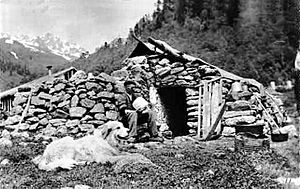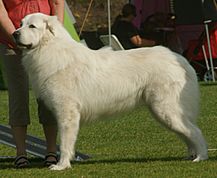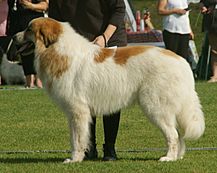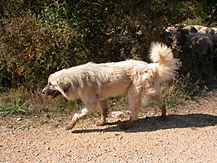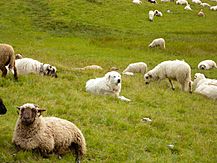Pyrenean Mountain Dog facts for kids
 |
|||||||||||||||||||||||
| Other names | Chien de Montagne des Pyrénées Great Pyrenees |
||||||||||||||||||||||
|---|---|---|---|---|---|---|---|---|---|---|---|---|---|---|---|---|---|---|---|---|---|---|---|
| Common nicknames | Patou | ||||||||||||||||||||||
| Origin | France | ||||||||||||||||||||||
|
|||||||||||||||||||||||
|
|||||||||||||||||||||||
| Domestic dog (Canis lupus familiaris) | |||||||||||||||||||||||
The Pyrenean Mountain Dog is a large, friendly dog breed from France. In France, it's known as the Chien de Montagne des Pyrénées or simply the Patou. In the United States, people call it the Great Pyrenees. This dog breed comes from the French side of the Pyrenees Mountains. These mountains separate France and Spain. The Pyrenean Mountain Dog is a different breed from the Pyrenean Mastiff, which comes from the Spanish side.
These dogs are often used as livestock guardian dogs. They help protect farm animals like sheep from predators. You can find them working in the French Alps and Pyrenees. They guard flocks from animals like wolves and bears. In the United States, they also protect farm animals from various predators.
Contents
History of the Pyrenean Mountain Dog
People believe the ancestors of the Pyrenean Mountain Dog came from Asia. They were brought to the Pyrenees Mountains by the Romans. These early dogs were white livestock guardian dogs. This means the breed might be related to the Maremmano-Abruzzese Sheepdog from Italy and the Kuvasz from Hungary.
For thousands of years, shepherds in the Pyrenees used these dogs. They were called Patou in France. Their job was to protect sheep and other animals from wolves and bears. To help them in fights, these dogs often wore heavy iron collars. These collars had long nails on them.
Shepherds sometimes used the Pyrenean Mountain Dog with a smaller dog. The Pyrenean Mountain Dog would guard the flock. The smaller Pyrenean Sheepdog would help herd the animals. Historically, these dogs also helped smuggle goods between France and Spain. They carried packs along mountain paths that people couldn't easily use.
Royal Dogs and New Breeds
In the 1600s, a Pyrenean Mountain Dog came to the court of King Louis XIV. This happened thanks to Madame de Maintenon and Louis, Dauphin of France. The breed quickly became very popular. King Louis XIV even named it the Royal Dog of France. French noble families then used these dogs to guard their large homes.
Some people think French settlers brought Pyrenean Mountain Dogs to Canada. They might have helped create the Newfoundland breed. In the 1830s, the Pyrenean Mountain Dog was also used to help create the Leonberger breed.
Saving the Breed
Over time, wolves disappeared from the Pyrenees. Because of this, the Pyrenean Mountain Dog became less popular. By the early 1900s, the breed was almost gone. Local shepherds sold puppies to tourists. This is how the dogs made their way to Britain.
A French dog expert named Bernard Senac-Lagrange helped save the breed. He traveled through the mountains to find the best dogs. He used these dogs to start a breeding program. In 1923, he created the first breed club. He also wrote the first official description for the breed. The Société Centrale Canine officially recognized the breed that same year.
In 1946, a similar large white dog on the Spanish side of the Pyrenees was recognized. This dog became known as the Pyrenean Mastiff. It has a slightly different official description.
Pyrenean Mountain Dogs in North America
In the early 1930s, the Pyrenean Mountain Dog came to North America. There, it became known as the Great Pyrenees. The breed became very popular in dog shows in both Canada and the United States.
The American Kennel Club adopted a new breed standard in 1935. This standard was different from the original French one. It focused on making certain physical features more noticeable. This sometimes changed the dog's original working form. Later, Britain's Kennel Club also adopted this standard.
To help keep the breed healthy and true to its working roots, a British breed club took action. In 2011, they told show judges to prefer lean, strong dogs. These dogs should have coats that protect them from weather. They should not reward dogs that look too "glamorous" or heavy.
What Does a Pyrenean Mountain Dog Look Like?
The Pyrenean Mountain Dog is a very large and strong dog. Male dogs usually stand about 70 to 82 centimeters (27.5 to 32 inches) tall. Female dogs are a bit smaller, from 65 to 77 centimeters (25.5 to 30 inches). Healthy adult dogs typically weigh between 55 and 75 kilograms (121 and 165 pounds).
Their head is not too big compared to their body. They have a long, wide snout and small, triangular ears that lie flat. Their neck is short and strong. They have a broad chest and a long tail. A special feature of this breed is that they have double dewclaws on their back legs.
Coat and Colors
The breed has a long, thick double coat. This coat helps protect them from bad weather. The outer coat is long and flat. It's especially long around their neck, tail, and the back of their legs. They also have a soft, thick undercoat.
Most Pyrenean Mountain Dogs are white. They can have patches of black, badger, grey, or tan, mostly on their head. "Badger" means a mix of brown, black, grey, and white hairs. This color is common in puppies but usually fades as they grow up. While some purebred dogs have black patches, this is not allowed in dog shows.
What is the Character of a Pyrenean Mountain Dog?
Pyrenean Mountain Dogs are known for being independent and protective. Male dogs tend to be more independent than females. As livestock guardian dogs, they have strong protective instincts. They will protect their family or flock whenever needed.
These dogs are very loyal to their whole family, not just one person. They are especially loving towards children. They are cautious around strangers but not aggressive. Pyrenean Mountain Dogs are smart and learn quickly. However, because they are so independent, they can be a bit challenging to train. It's important to start obedience training early. If you don't, their large size can make training difficult later on.
Pyrenean Mountain Dogs as Livestock Guardians Today
Today, the Pyrenean Mountain Dog is still used for its original job. They guard livestock for shepherds in the French Pyrenees and the French Alps. They are also used in the United States.
In France
In the early 1980s, farmers in central France had problems with stray dogs attacking their sheep. So, a French institute started an experiment. They gave about 15 Pyrenean Mountain Dogs to farmers. By the late 1980s, an association was formed to help provide these guardian dogs to farmers. By 1991, about 100 dogs were working on farms.
In the early 1990s, wolves started coming into France from Italy. They settled in about one-third of France, especially in the Alps. Wolves are protected in France. To help farmers, the French government started giving money. This money helped farmers protect their flocks from wolves. They could use it for electric fences, secure night pens, extra farm workers, and buying and training guardian dogs.
Since livestock guardian dogs had been gone from the French Alps for over 100 years, the Pyrenean Mountain Dog was chosen for this reintroduction. This was because trials had already shown they were good for the job.
In the mid-1990s, the French government also started bringing European Brown Bears from Slovenia into the Pyrenees. This was to save the bear species there. With more bears, shepherds reported more losses of their animals. To help, the government provided funding for the same protection methods used for wolves. Pyrenean Mountain Dogs were brought back to the Pyrenees to guard flocks from bears.
Studies in the mid-2000s showed that shepherds using Pyrenean Mountain Dogs lost 90% fewer animals to predators. However, there have been some issues. Hikers in the mountains have reported being attacked by these guardian dogs. This happens when the dogs are protecting their flocks.
By 2009, over 1,000 Pyrenean Mountain Dogs were protecting flocks from wolves in the Alps. Another 500 were protecting flocks in the Pyrenees. In 2019, the French government helped fund the care of over 4,200 guardian dogs across the country. Most of these were in the French Alps.
In the United States
Starting in the late 1970s, sheep farmers in the United States began using livestock guardian dogs. They wanted to protect their flocks from predators like coyotes, black bears, cougars, and grizzly bears. One reason for this change was new rules about using poisons to control predators.
A survey in 1986 looked at over 400 farmers using guardian dogs. It found that 57% of them used Pyrenean Mountain Dogs. Other breeds like Komondors, Akbashs, Anatolians, and Maremmano-Abruzzese Sheepdogs were used less often.
See also
 In Spanish: Perro de montaña de los Pirineos para niños
In Spanish: Perro de montaña de los Pirineos para niños


